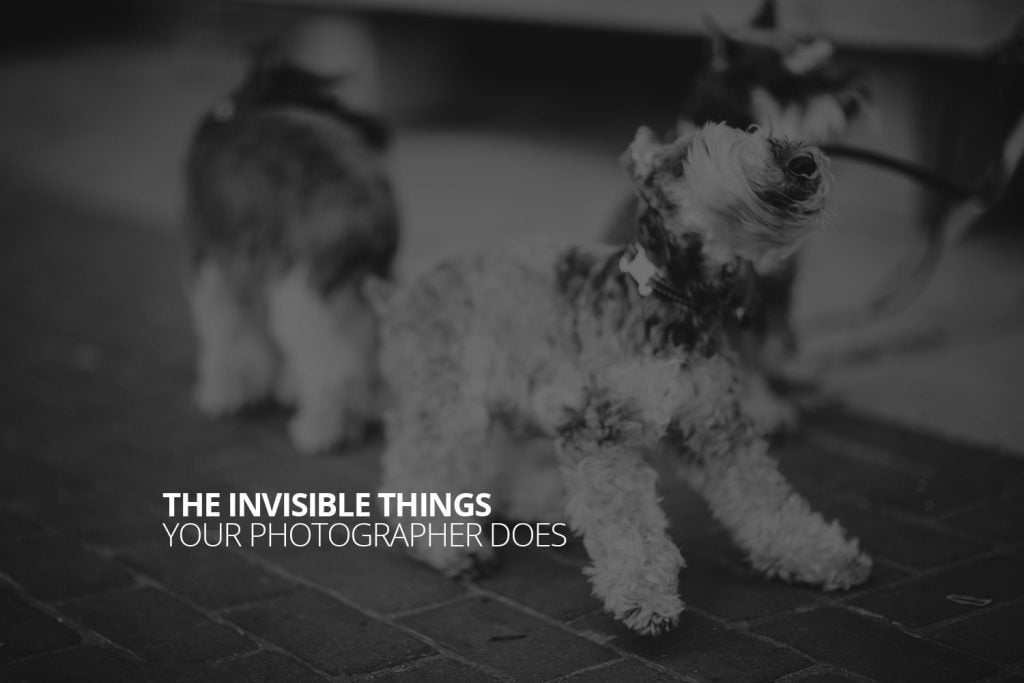Being a photographer is easy right? Just show up with a camera, take a few pictures, bing bang boom, photography! Right? Well, no. But you probably already knew that. What you probably don’t know, is just how much you don’t know. Lots of people, acquainted with a selfie or a photo of their mocha latte taken with a smartphone, know enough to think it’s easy—and it is for the majority of situations that call for some kind of photo. But they don’t know enough to know how much more goes into the right photo.
There are photos (“Aw, my dog is cute”, “look how cool the design on this mug is”, “I can’t believe I ran into you, lets get a selfie”), and there is the right photo (“I haven’t seen mom in 6 years”, “I think this might be my cute dog’s last summer”, “I’m only getting married once”, “I really need to get a better job”). When there’s something specific you want or need, getting the right photo involves a host of invisible things only a photographer would really think about. And, in fact, only a photographer is trained to make thinking about them easy.
So, what are those invisible things your photographer is doing and thinking about? Here’s a non-exhaustive list to get the gears turning.
They’re thinking practically, then creatively
A photographer who starts creatively, often doesn’t finish. Our creative minds can visualize an end-result that the practicalities of our circumstances sometimes just don’t support. If a photographer wanted to shoot a photo that looked like it was taken in zero gravity, they’d want to start with the practicalities of simulating a gravity-free environment first. Will it be a well timed jump-and-pose? Will it be a support system, like a ladder or a harness, removed later with the help of photoshop? Once a photographer answers these questions, they could move onto creative aspects like light, setting and background.
If instead, they just went out and tried to take the photo, they might spend all day and still walk away with something mediocre. The planning, and practical thinking your photographer does before, and during your session, is part of what leads to a successful shoot and the right image.
They’re making sure the equipment is in tip-top shape
Dust, scratches, debris, technical mishaps due to wear and tear. These are things a photographer spends time on before they’re spending time with you. And it’s an important aspect virtually no one (without a best friend who’s a camera) thinks to ask. So, let me ask you a question—when was the last time you took a microfiber cloth to your smartphone lens? What’s that? Never?
Something as simple as cleaning the front of the lens on the camera, so that it’s crystal clear, has heavy bearing on the clarity of the images. Even a slight film, or thin haze on the lens—such as from finger print smudges after you try to clean them off with your shirt—reduce the contrast and detail of images. You don’t think about these things, but your photographer does. They just never talk about it.
They’re looking out for weird colors
You have certainly noticed how photos taken near LED lights, traditional lightbulbs, fluorescent light, daylight, shade, sunset—they all have different colors. LED’s give off a bluish or purplish light. Traditional bulbs are really yellow. Fluorescent is this sickly green color. Daylite and shade are a slightly warm white, and sunset might be bright pink. We could go on.
We’re used to the way the color of light changes our view of a scene. What we’re not used to, in a photograph at least, is the way the color of light makes skin tones look so strange. Fluorescent light can literally make a person look like they’re sick. A good photographer sees how the color of the light is twisting skin tones before they even take the photo. And they continue to think about it as they process and color correct the photo to account for the color of the light. Most photographers don’t think outloud about these things, and unless you look through the raw images, you’d probably never know how bad the color might’ve been.
They’re thinking about the visual language of the image
A century of photography has created an informal dictionary of visual language that people tend to understand implicitly. The direction and position of lights mean something. A subject’s pose means something. The juxtapositions or alignment of backgrounds and props all mean something. The cultural context means something. It’s easy for an amateur to inadvertently repeat stereotypes and make statements with their images, that they may be unaware of. But viewers, in varying degrees, have a gut sense for them.
Folded arms could be confidence, or it could be insecurity—a good photographer would know and direct you away from the appearance of insecurity. A child, dirty from playing in the backyard all day, photographed from behind a chain link fence looks like a statement about poverty—-a good photographer knows to get the fence out of the frame. These are processes that would likely go by silently in the mind of a photographer, and you might never even consider it. Moreover, if the image is of you, or someone you love, you’re probably not going to be able to see the raw visual language through your sentimental attachments to the people in the images. But others probably can.
They’re controlling for things you would only notice if they didn’t control for them
There are a lot of things you likely notice when they’re bad. Posture, for example. When you have good posture in a photo, it’s just a good photo. When you have bad posture in a photo, it’s clear as day. There are a lot of these things involved in a photographer’s work. Things that would look bad if they weren’t addressed, but things that would be invisible if they are. Wardrobe falling in a flattering way is another good example—get it right, and it’s a nice outfit. Get it wrong, and it screams at you every time you look at it.
It’s not just while shooting though. You probably don’t know what a raw image looks like. That’s okay. They don’t look great. A raw image is the data, directly off the camera sensor, without any modifications; They’re low contrast, desaturated, and leaving intact all the small imperfections that developed on your face overnight. After a shoot is done, a photographer takes care to “process” these images to give them the vibrance, contrast and tone they need to be eye catching. Sometimes spending as much as 10 to 20 minutes on each photo.
Even more than that—Do you remember where zits or other skin blemishes were on your face, say, on September 12th, 2015? No, probably not. Those things were incidental. You’ll forget you even had them after they’re gone—unless they appeared forever in a photo. Part of what our photographers will do while processing photos is to remove the non-permanent blemishes, so that you can forget you had them. We won’t make a big hoopla about it either. It’s a invisible, and thankless part of the work because if we’ve done it right, you won’t know we did anything at all.
Want to Learn More About Us?
We’d love to work with you for all your portrait and event needs. We’re doing the thinking, so you don’t have to. If you’d like to learn more about our portrait photography services, or book a session online right away, you can do so over on our portraits page. We also work with lots of clients to capture their weddings completely and skillfully, so if you’re getting married, be sure to check out our weddings page. Finally, if you’re starting a business, a sales job, or looking for new work, let us create some stand out headshots for you, over on our page For Professionals.

